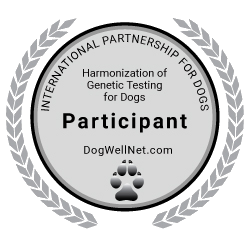Lysosomal storage disease (LSD)
Lysosomal storage diseases (LSDs) are a diverse group of inherited disorders characterised by... more
Disease
Lysosomal storage diseases (LSDs) are a diverse group of inherited disorders characterised by progressive neurological symptoms that share a common feature: the abnormal intra-lysosomal accumulation of one or more classes of incompletely catabolized macromolecules.
A genetic variant in the gene CNP is causing lysosomal storage disease in Dalmatian dogs. Affected dogs show slowly progressing symptoms like abnormal behaviour, cognitive decline, loss of coordination, apparent visual impairment, anxiety, pacing and circling, hypersensitivity, sleep disturbance and loss of control over urination and defecation. First symptoms become apparent at the age of 18 months. At the age of 7 years difficulties with balance can be seen as well as signs of disorientation. The dogs tip over while walking, walk into obstacles and often lean against objects for support. Magnetic resonance imaging of these dogs showed marked generalized brain atrophy with pronounced white matter degeneration. A later-onset neurological disorder occurred in some dogs heterozygous for the mutation. Symptoms are also progressive but less severe. Clinical signs develop at the age between 9 and 11 years and include loss of appetite, ataxia, restlessness or sleep disturbance. At the age around 12 years some dogs exhibit significant loss of coordination; they fall over and have difficulties standing up again. Some dogs also have signs of visual and hearing impairment.
In the breed Doberman, a genetic variant in the MAN2B1 gene was found to be responsible for the lysosomal storage disease. First symptoms could be noticed in an affected dog very early at around 2 months including clumsiness and difficulties in standing with frequent falls. A neurological examination revealed slightly obtunded mentation, proprioceptive ataxia, asymmetric reduced menace response and moderate divergent strabismus. Over the course of the disease progression, aggressiveness towards other dogs, intolerance of grooming and bathing, compulsive behaviour like circling and inappropriate vocalization as well as uncoordinated movements and difficulties in navigating stairs developed. Due to the progression of neurological signs, including dementia and apparent hallucinatory behavior characterized by trying to interact with non-apparent stimuli or reacting to open areas/empty spaces, the affected dog was euthanized at the age of 14 months.
A genetic variant in the gene CNP is causing lysosomal storage disease in Dalmatian dogs. Affected dogs show slowly progressing symptoms like abnormal behaviour, cognitive decline, loss of coordination, apparent visual impairment, anxiety, pacing and circling, hypersensitivity, sleep disturbance and loss of control over urination and defecation. First symptoms become apparent at the age of 18 months. At the age of 7 years difficulties with balance can be seen as well as signs of disorientation. The dogs tip over while walking, walk into obstacles and often lean against objects for support. Magnetic resonance imaging of these dogs showed marked generalized brain atrophy with pronounced white matter degeneration. A later-onset neurological disorder occurred in some dogs heterozygous for the mutation. Symptoms are also progressive but less severe. Clinical signs develop at the age between 9 and 11 years and include loss of appetite, ataxia, restlessness or sleep disturbance. At the age around 12 years some dogs exhibit significant loss of coordination; they fall over and have difficulties standing up again. Some dogs also have signs of visual and hearing impairment.
In the breed Doberman, a genetic variant in the MAN2B1 gene was found to be responsible for the lysosomal storage disease. First symptoms could be noticed in an affected dog very early at around 2 months including clumsiness and difficulties in standing with frequent falls. A neurological examination revealed slightly obtunded mentation, proprioceptive ataxia, asymmetric reduced menace response and moderate divergent strabismus. Over the course of the disease progression, aggressiveness towards other dogs, intolerance of grooming and bathing, compulsive behaviour like circling and inappropriate vocalization as well as uncoordinated movements and difficulties in navigating stairs developed. Due to the progression of neurological signs, including dementia and apparent hallucinatory behavior characterized by trying to interact with non-apparent stimuli or reacting to open areas/empty spaces, the affected dog was euthanized at the age of 14 months.
Breed
Dalmatian,
Dobermann
Heredity
unclear, see text
Test duration
1-2 weeks after arrival of the sample in the lab


